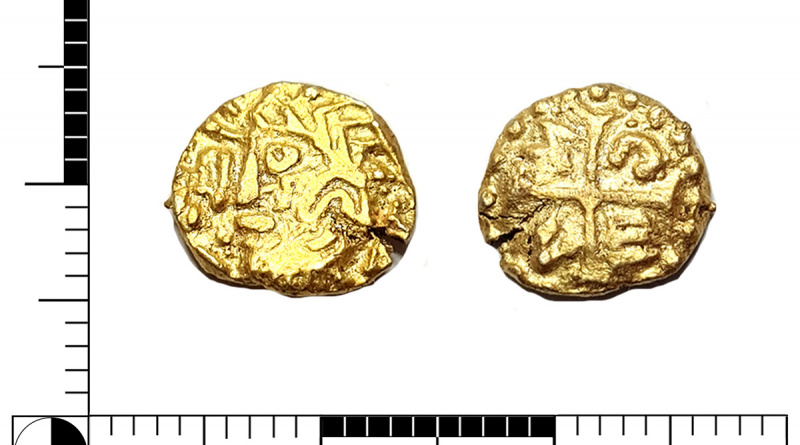LEMC type of gold thrymsa
A gold thrysma, dated to c. AD 600-750, with “LEMC” in the quarters on the reverse. The PAS record says “This coin is the first of it’s type to be found as a single find, with other examples recorded in the Crondall Hoard“.
Crondall Hoard
In 1828, 18 year-old Charles Lefroy was out shooting with his gamekeeper in Crondall, Hampshire. In a letter to the Numismatic Chronicle, dated 13 June 1843, he described the find:
“The coins which you have received from me for the purpose of publication in the Numismatic Chronicle were found by myself in the autumn of 1828 on a heath in the parish of Crondall in Hampshire. This heath is a continuation of Bagshot Heath. The boundary of the counties of Surrey and Hampshire cross it in the parish of Crondall, skirting an old encampment, situated on the abrupt point of a hill called “Caesar’s Camp within about a mile of which or a little more on the flat waste below I discovered these coins. A turf had been pared off for firing in the usual manner, leaving a smooth “dished” surface on the centre of which I saw a little heap of apparently brass waistcoat buttons lying mixed with earth but with the bright edges just washed bare by the late rains
On picking them up they proved to be these gold coins and the two jewelled ornaments and chains. The coins must have been confined in a purse, though there was no trace of one left, as some of the stones set in the ornaments had fallen out but were found among the coins together with a little stone, since lost probably belonging to some other ornament which had perished.
They were lying altogether on the surface completely cut out by the turf-cutter’s spade and upon a slight search which I made I could find no trace of any more. The collection consisted of one hundred small gold coins, the two jewelled ornaments and chain one of which was perfect at the time of their discovery and one fragment of a forged gold coin of which the circumference was perfect but the centre decayed.“
The 100 coins consisted of 73 Anglo-Saxon thrysmas, 24 gold Merovingian or Frankish tremisses and three unstruck gold planchets. It remains the only large hoard of Anglo-Saxon thrysma ever found and is now on display at the Ashmolean Museum. The hoard is thought to date to 635-650.
There were 12 different types of Thrysma of Anglo-Saxon manufacture in the hoard. Until this find, 5 of the 12 types are only known from this hoard. That is now 4. Only one has an interpretable inscription, of Eadbald of Kent.1 That coin has been dated to c. 620-630.2 It is the first coin issued in the name of an English king.

